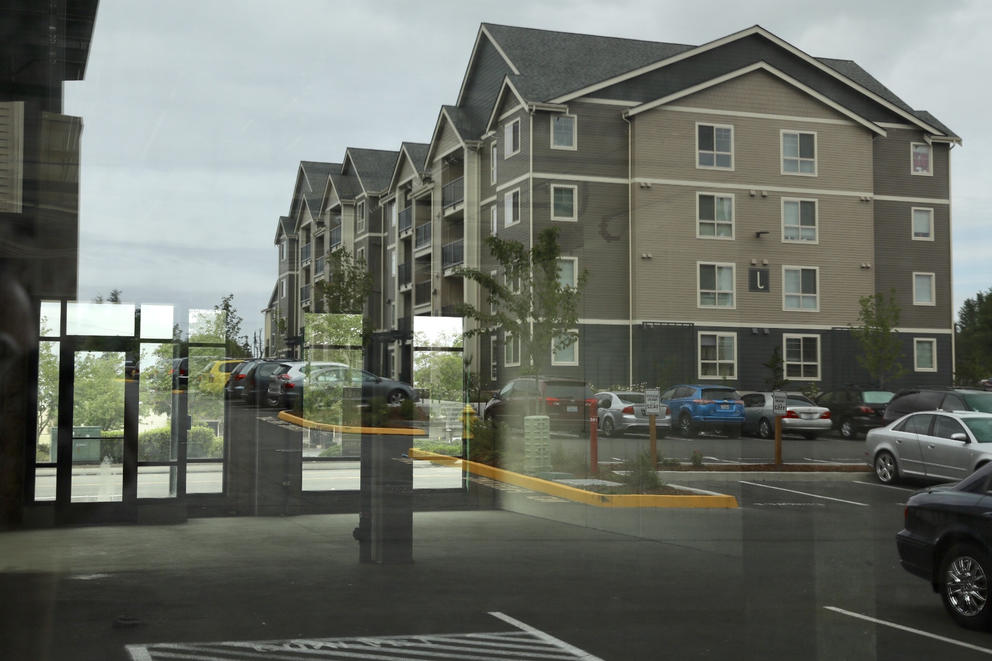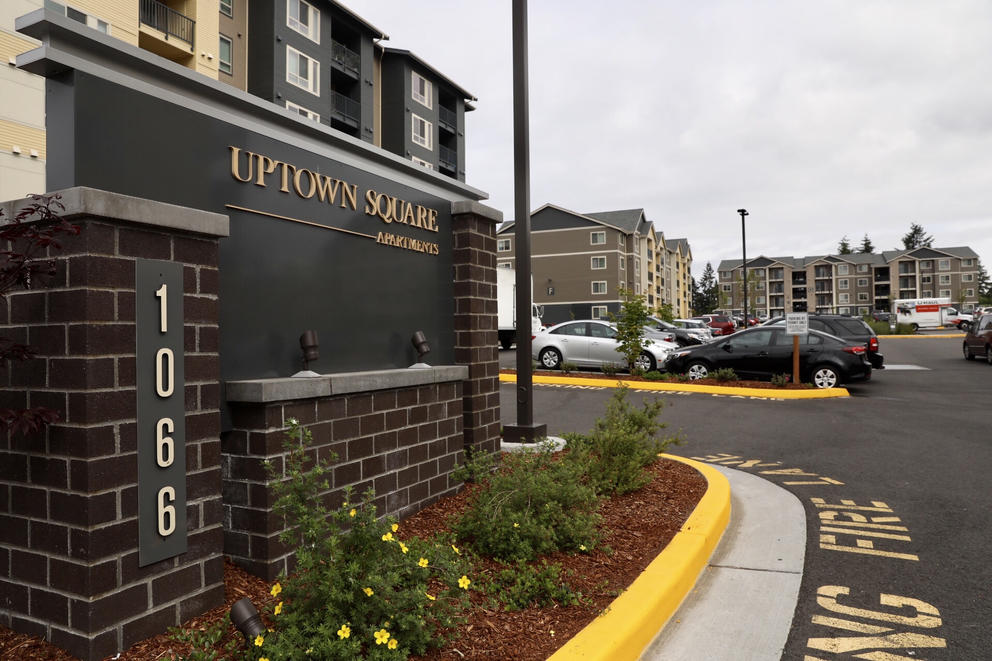A moratorium for certain types of development was imposed in the central part of Issaquah, allowing city officials to halt new construction and give themselves time to recalibrate their design and building standards — particularly to make sure whatever project came next would be something the city would actually want around for decades to come.
“It caused [the city council] to go: ‘Wait a second. Time out. I don’t think we got this right,’ ” recalled Keith Niven, Issaquah’s economic development and development services director.
Issaquah’s is just one example in recent years of a city in the Puget Sound region giving itself such a breather amid the waves of relentless development that have emanated from Seattle’s growth.
At one point last fall, King County alone had five cities — including Issaquah — with a building moratorium in effect to temporarily halt some forms of development for one reason or another. Currently, there are at least a handful of active moratoriums across the Puget Sound region. The moratoriums stretch from Gig Harbor in Pierce County to Granite Falls in central Snohomish County.
For the cities that enact such temporary bans on growth, the policies provide a chance to revisit and update local codes and zoning ordinances to make sure future development is in line with a community’s vision of itself.
But some experts in land-use laws and advocates for builders argue that moratoriums don’t come without consequence. They dissuade businesses and developers from investing in a community and increase costs by delaying projects not yet in a city’s permitting pipeline. They also, in critics’ eyes, carry the potential to be easily abused as a means to mask anti-growth attitudes in communities not accustomed to their new reality in an urbanized region.
Under Washington’s Growth Management Act, cities can adopt moratoriums only under very narrow circumstances, generally only when something constitutes an emergency likely to cause harm to the community.
“The general rule, in the U.S., is that moratoria are OK; they’re legal — if reasonable in scope and time,” said Charles R. Wolfe, a Seattle land-use lawyer and author who has taught planning law at the University of Washington for 20 years. (Wolfe was previously a contributor to Crosscut from 2009 to 2015, writing under the byline of Chuck Wolfe).
Washington state law limits moratoriums to six months, but they can be renewed in additional six-month increments if local elected leaders determine the emergency still merits one or if further study is required to address the problem.
“When there’s so much change going on within a given market or submarket, it’s an opportunity to say: ‘Wait a minute, we don’t know if we have the regulatory capacity to deal with this,’ ” Wolfe said. “It allows some pause.”
In rare cases, a moratorium is a necessity, literally.
That’s pretty much the case in rural Granite Falls in Snohomish County, about 13 miles northeast of Everett. City Council members in the town of 3,500 people recently imposed a six-month moratorium on most new connections to the city’s sewer system, because the system itself is almost at capacity.
In seeking the council’s approval last month, city staff wrote that the wastewater treatment plant had capacity to serve only 643 more residential units when, as of March, there were already 553 units in the permitting pipeline to be built. The city simply wouldn’t have the ability to handle further development at such a pace without increasing its sewer capacity.
Other cities have offered different impacts of growth to justify a moratorium.
Sammamish cited traffic impacts in imposing temporary development restrictions in December. In halting new building permits, the Bainbridge Island City Council in January said rapid development and deforestation were threatening its fresh water aquifers, the Kitsap Sun reported.
For some communities — like Issaquah, Federal Way or Gig Harbor — the moratoriums appear to stem more out of a community desire to maintain the character of once-small, detached suburbs, where many Seattleites are now flocking as they seek a quality of life that’s more affordable.
Federal Way put the brakes on building more apartment complexes in June 2016 with a moratorium that officially lasted about a year. Federal Way Mayor Jim Ferrell said the genesis for the emergency measure was the influx of apartment units at such a brisk pace and in such volume that it not only ruffled longtime residents but also overburdened local schools.
“This was like a tsunami that was slowly in the making, and before the community really had a chance to absorb this, the next thing you know we had nearly 1,000 units that came online rapidly,” Ferrell recalled.
One of those projects, Uptown Square Apartments, involved developing an old school-district bus barn into a housing complex with hundreds of units — adjacent to Highway 99 where tens of thousands of cars commute every day. “I think the elected officials and the people at city hall really underestimated the impact” of such development, Ferrell said.
As with other cities, Ferrell said Federal Way leaders sought the moratorium to give themselves a chance to modernize city codes and development standards. Without it, developers could continue to file applications with the city under existing regulations until the new ones were approved.
“There seemed to be a feeding frenzy, or a perception in the community that this was a runaway situation,” Ferrell said. “We were concerned that yet another application would get dropped and that we would essentially lose control over how our city was going to be growing and developing.”
Although Federal Way’s moratorium lifted about a year ago, the city and the Federal Way School District meanwhile pursued a policy decision that has the tangential impact of continuing, at least somewhat, to deter development: school impact fees.
At the school district’s request, Ferrell said Federal Way city leaders agreed in 2017 to hike the one-time fee on builders to more than $20,000 per multifamily housing unit — an increase of about 700 percent from a fee that a couple years prior had been only about $2,900 per unit.
Ferrell said the district’s schools are “completely over-capacity,” and not only are new schools needed but aging schools need to be rebuilt. (Voters in the Federal Way School District also passed a $450 million bond last year to pay for school construction.)
“I think that [impact fee increase] will likely address the boom in multifamily housing,” Ferrell said, but quickly added: “That’s certainly not something that it was designed to curb — it was designed to address the infrastructure in case more multifamily housing comes up.”
Over in Gig Harbor, a recent moratorium on new residential development was justified by the impacts of rapid growth — from traffic congestion to deforestation — on a once-rural area.
The city has had a 30 percent growth rate in the last five years and is already coming close this year to reaching its growth goals for 2030, said Gig Harbor’s senior planner Peter Katich. The swift pace of development “has transformed our community from one with lot of open space and one that’s undeveloped, to one where almost every parcel is developed or has somebody eyeballing it for development.”
But the emergency measure fulfilled political goals, too. In 2014, several city council members were elected after running on a platform of “no growth” or “slow growth,” Katich noted.
“A lot of residents have been very supportive of [the moratorium], because of concerns they have expressed and the support they gave to elected officials,” he said. “During their campaigning, [the council members] had promoted trying to do what could be done to decrease density. They’re now fulfilling some of those campaign pledges, and we’re moving forward to try and re-examine all residential development regulations.”
It’s that kind of underlying motivation for moratoriums that concerns Wolfe, the UW professor, as well as advocate organizations that represent builders, whose industry and livelihood relies on communities’ continued growth and development.
“If it’s applied reasonably or for a limited period of time, it’s not a bad idea,” Wolfe said. “The problem is when it’s applied for political reasons — say council members who are feeling the pressures of NIMBY groups and there’s subterfuge going on. Where all the right words are articulated [to legally justify a moratorium], but really, it’s just a matter of ‘not-in-my-backyard,’ and that’s not good for development.”
Allison Butcher, senior policy analyst at the Master Builders Association of King and Snohomish Counties, urges local elected leaders to avoid moratoriums altogether, because “that’s a drastic measure to do.”
The state’s Growth Management Act already requires communities to plan extensively for the future, and cities “legitimately need to keep their codes updated and make sure they have that in line for development to go forward,” Butcher said.
“We are just obviously continuing to grow at a fast place and instituting a building moratorium isn’t going to stop that. The growth is coming whether there’s a moratorium in place or not,” Butcher said. “Where we are right now with our housing and affordability crisis, and with our strong demand and population growth, we should be thinking about ways to increase housing and choices. … There’s already enough hurdles to adding housing, and we don’t need anymore.”
For Issaquah, a moratorium wasn’t about deterring all future growth. The city just wanted the right kind of growth for itself, said Niven, the development director.
The construction of the Atlas apartments — with the complex’s bold blue paint and its absence of mixed-use space on the ground floor — served as a symbol of what Issaquah did not want in seeking more new development. “People just called it ‘Orlando architecture,’ because the buildings aren’t necessarily remarkable and they really could be built anywhere,” Niven said.
“Get rid of single-story, 1980s suburban retail and replace it with multi-story, denser projects that will accommodate growth and create a more vibrant part of the city in central Issaquah — that’s what [city leaders] wanted, but we weren’t necessarily getting that,” he said.
That’s why the council approved the moratorium and city staff spent the next 21 months revamping city code, including parking requirements for new development and creating a design and architectural manual to guide the aesthetics of future projects right down to what colors and doors builders could use, Niven said.
The moratorium was also a chance to address another problem council members and city staff there had observed. Despite their declarations of wanting affordable housing, none was coming. In the summer of 2016, 964 new residential units were in the pipeline to be built, but zero of them was designated as affordable, Niven recalled.
Through the moratorium, the city also developed a strategic plan to help diversify the city’s housing stock going forward, he said — such as through reducing barriers for accessory dwelling units and testing out a tax exemption for affordable multifamily housing.
Issaquah’s moratorium lifted only just last week, on May 21, and it’s too soon to tell what impact the changes in development policies crafted during the pause might have in reality. “You don’t know if all the tools you just bought are going to be effective; they might just sit in the toolbox. You still might get Orlando architecture — I don’t think so, but it’s possible,” Niven said.
Somewhat like Federal Way, the city might very well have incidentally given itself an unofficial restriction on future development, Niven said. “Did we turn everybody away? Or did we pass so many regulations that we scared everybody off? It could very well be that, by all the things we’ve done, there’s a de facto moratorium still in place. We just don’t know that yet.”




